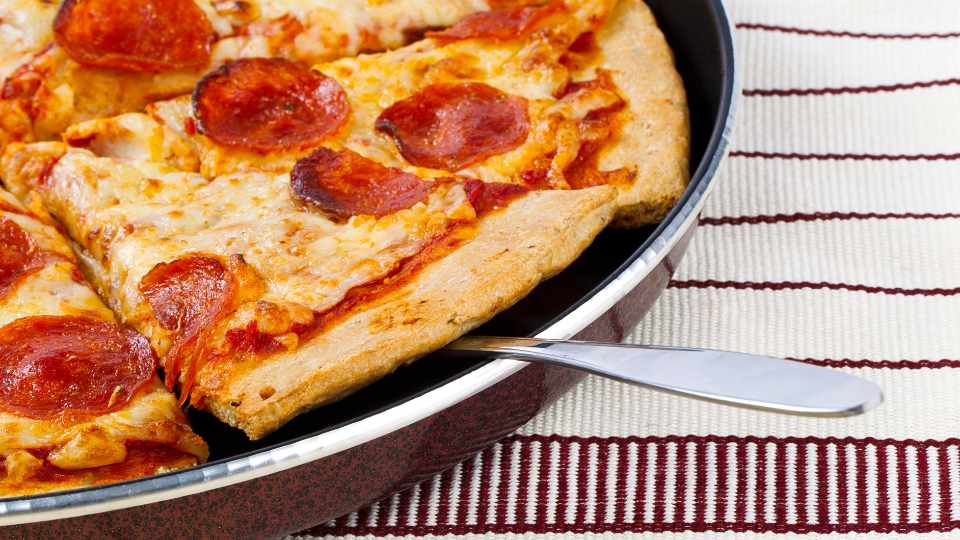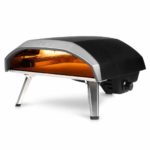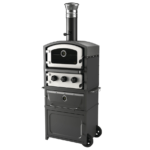What Is Pan Pizza? Is It Different From Hand-Tossed Pizza?
Are you a pizza aficionado looking to broaden your palate?
Wonder what is pan pizza, and how it compares to hand-tossed pizza? You’ve come to the right place! In this blog post, we’ll explore what makes pan pizza different from standard hand-tossed pies, including the dough texture, cooking technique, and crust size.
Get ready for a mouthwatering tour of deliciousness as we compare two popular types of delectable pizzas.
What Is Pan Pizza?
Pan pizza, also called thick crust pizza or deep dish pizza, is a type of yeast-leavened pizza that has its origins in Italy. It’s characterized by a large diameter and very thick crust with sloping sides which differs from the thinner traditional Neapolitan pizzas baked on flat pans.
The dough used for pan pizzas is thicker than hand-tossed pizza, making it chewier and sweeter with an extra rise in the centre near the edge.
The crust has a fluffy texture similar to focaccia, while both pan pizza and hand-tossed pizzas have crispy bases. Hand-tossed pizzas are rolled and tossed in the air resulting in a thinner stretchier light crust when compared to pan pizza as it has an oily base which gives them more moisture, volume and richness.
In contrast, pan pizzas have dry basins resulting in crispiness and crunchiness, unlike their moist counterparts.
What Makes Pan Pizza Special?
It is a popular style of pizza that offers an array of unique characteristics and indulgent flavours. Unlike traditional hand-tossed pizzas, pan pizza dough is made from all-purpose flour, water, yeast and salt, resulting in a thick and fluffy texture similar to focaccia.
An often overlooked factor in pan pizza’s deliciousness is the type of pan itself.
When it comes to toppings for pan pizza, meat lovers have plenty of options such as pepperoni slices, sausage crumbles and ham cubes which create delectable combos with crunchy mushrooms or creamy mozzarella cheese on top.
How To Make Pan Pizza At Home

Choosing The Right Pan
When it comes to making pan pizza, the first important decision to make is what type of pan should be used. The best toe for cooking pizza on the hob is a cast-iron pan. It ensures an evenly cooked crispy crust and can reach higher temperatures than other types of pans, allowing pizzas to cook faster.
For those who don’t have access to an oven, using an overproof or fireproof deep dish pan is recommended when making either fresh or frozen pizza since it’s designed explicitly for stovetop baking in high-heat environments without burning your crust too quickly.
Preparing The Dough And Toppings
Making a delicious pan pizza starts with the dough and toppings. The type of flour used is key; all-purpose, bread flour or Italian “00” will work best. You can use your own recipe to make the dough, but if you are short on time, premade dough is also an option.
Kneading the dough for five minutes ensures that it develops enough gluten to form air bubbles, giving it a nice texture and flavour. Once kneaded into a smooth ball shape, place in an oiled bowl and cover with a damp cloth or wrap in plastic wrap until it has doubled in size; this should take about two hours depending on temperature and humidity levels.
When choosing toppings for your pan pizza, think about flavours that pair well together such as olives and tomato sauce or ham and pineapple chunks. Select ingredients with different textures so there’s something unique about each bite, like chopped vegetables mixed with succulent pieces of meat or vegan faux meats.
Perfecting The Cooking Process
When it comes to making pizza, pan pizza can be an excellent option for a delicious homemade meal. While it is relatively easy to make and requires minimal ingredients, the key to successful pan pizza lies in perfecting the cooking process.
First and foremost, properly selecting the right type of pan or pot is essential. Cast iron pans are preferred because they are able to withstand extremely high heat while also creating a unique flavour profile.
When it comes to preparing the dough and toppings, cold fermentation (a process that uses dough made ahead of time which can be allowed to rise in the fridge) is best as this allows for slower rising for additional flavour development; otherwise, regular yeast recipes will do just fine when proofed at room temperature.
For added crispiness, use extra-virgin olive oil on top of your unopened ball of dough before baking: The oil prevents moisture from forming on the top layer so that all parts of the crust bake evenly during the baking process.
Popular Variations And Toppings
Meaty Delights
When it comes to pan pizzas, one of the most popular types of toppings is meaty delights. Popular examples include slices of pepperoni, pieces of ham and bacon, diced sausages or crumbled hamburgers.
The bold flavour and texture that these meats provide help to enhance a pizza with complex and interesting layers. However, when adding this type of topping care should be taken over the cooking process; not only do you need to ensure that the crust cooks through in a consistent way around all sides but also consider how such ingredients can burn if cooked too quickly at high temperatures.
Experimentation is key when combining different meat toppings on a pan pizza; combining cubes or strips of chicken with roasted red peppers creates an acidic contrast while sausage paired together with mushrooms brings extra moisture as well as plenty of savoury aroma and umami flavours into play.
Using fresh ingredients like cured salami or anchovies alongside herbs such as oregano and parsley will add further complexity alongside aromatics such as garlic oils.
Veggie Options
When it comes to pan pizza, there are countless ways to create delicious and satisfying veggie options. Popular choices include sliced mushrooms, bell peppers, onions, olives, artichoke hearts or sun-dried tomatoes – truly something for everyone! For a healthy twist on this classic dish, swap out traditional mozzarella cheese for vegan cheese alternatives such as vegan Daiya cheddar shreds or soy feta.
If you’re feeling adventurous add some roasted vegetables such as cauliflower florets tossed in fragrant herbs like sage and oregano. Not only do veggie toppings lend flavour and texture to your pizzas but they also come with undeniable health benefits – think fibre, antioxidants and essential vitamins.
Regional Varieties
When it comes to pan pizza, there are endless regional varieties with unique flavour and texture profiles. Take the windswept coasts of New England, where saucy Seafood Pizza is a popular favourite.
True to its name, the crust is topped with melted butter and draped in juicy clam sauce or white sauce mixed with sweet garlic before being finished off with succulent shellfish such as shrimp, scallops, lobster pieces and clams.
Conclusion
Pan pizza is a delicious and versatile meal which can be enjoyed in multiple forms depending on personal preferences. While it may seem complicated to make pan pizza at home, with the right ingredients, resources and preparation steps, you can create your own version of this classic dish.
You should choose the right pan for the perfect crust and use fresh quality ingredients for the filling – from pepperoni, cheese and mushrooms to bacon bits or spinach leaves.
Additionally, when preparing a golden-brown crust consider preheating your oven properly before placing the dough in it.






